Whether you’re a proud dog parent or feline fan, it goes without saying that our furry friends can leave plenty of mess and marks behind on our floors. From toilet-training accidents to mucky paw-prints and unintentional scratch marks, protecting your floors from daily dirt and pet-related grime can be quite a challenge.
That’s why it’s so important to have an understanding of the best flooring for dogs, cats, and all our other pet companions. Not only will the right surface underfoot make it that much easier to wipe away any soilage, but it can also stop your pets from injuring themselves due to sudden slips and slides.
So, to help you decide just which material is the best for pet friendly flooring, we’ve listed out the pros and cons of all the various types of flooring you might encounter in the home, as well as some handy tips to avoid your pets staining your floors to begin with.
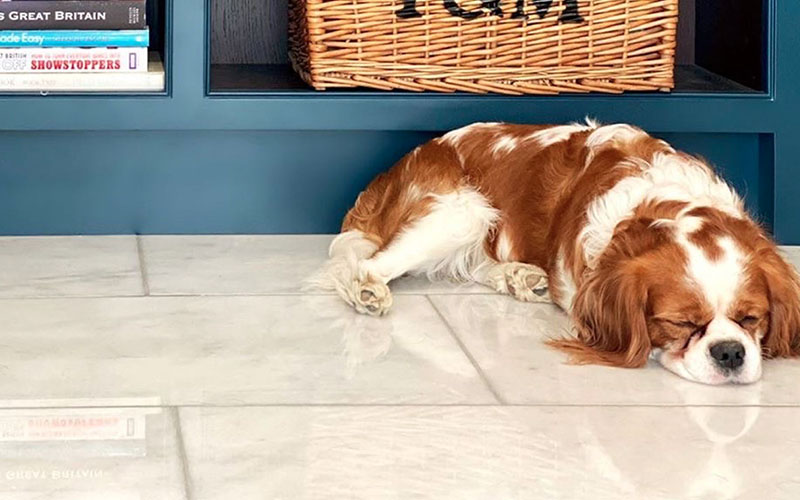
What to consider when choosing flooring for pets
First things first, when considering any type of pet-friendly flooring, it’s worth thinking about exactly what you should be looking for in your chosen flooring material. For example, the best flooring for dogs should be focused on durability, while all pet-friendly flooring should ideally be resilient against scratches.
Of course, this is just the start of your pet flooring considerations – after all, anyone who’s bringing home a puppy knows that toilet-training accidents are a given, making stain and water-resistant and easy-cleaning floor materials a must.
Finally, some types of flooring material can be slippery for pet’s paws and could result in accidental slips and slides when they’re burning off those excess bursts of energy – something you’ll probably need to avoid to reduce the risk of injury.
What are the different flooring options for pets?
Now that we’ve touched on what to consider when looking for the best flooring for pets, let’s examine the different pet flooring options out there and what sort of qualities they can offer pet owners:
Porcelain and natural stone tiles
When it comes to the best flooring for cats and dogs, natural stone and porcelain tiles often come at the top of the list – and for good reason.
Not only are these sorts of tiles extremely tough and durable, making them scratch and dent-resistant, but their solid surface makes them practically waterproof and resilient against staining, so it’s easy to mop up any leftover urine or mud.
Add to this their textured surface, and you can be sure that your pet won’t be skidding from one side of the room to the other. However, that being said, tiles like these are not the cheapest of floor options, and not all tiles hold the exact same qualities.
For the best results against your pet’s foot traffic, you’ll want to select a hard-wearing stone or porcelain, as softer stones can be worn down over time. You’ll also need to make sure you seal your natural stone tiles properly, otherwise, they could quickly absorb any stains and odours they’re exposed to without this protective layer.
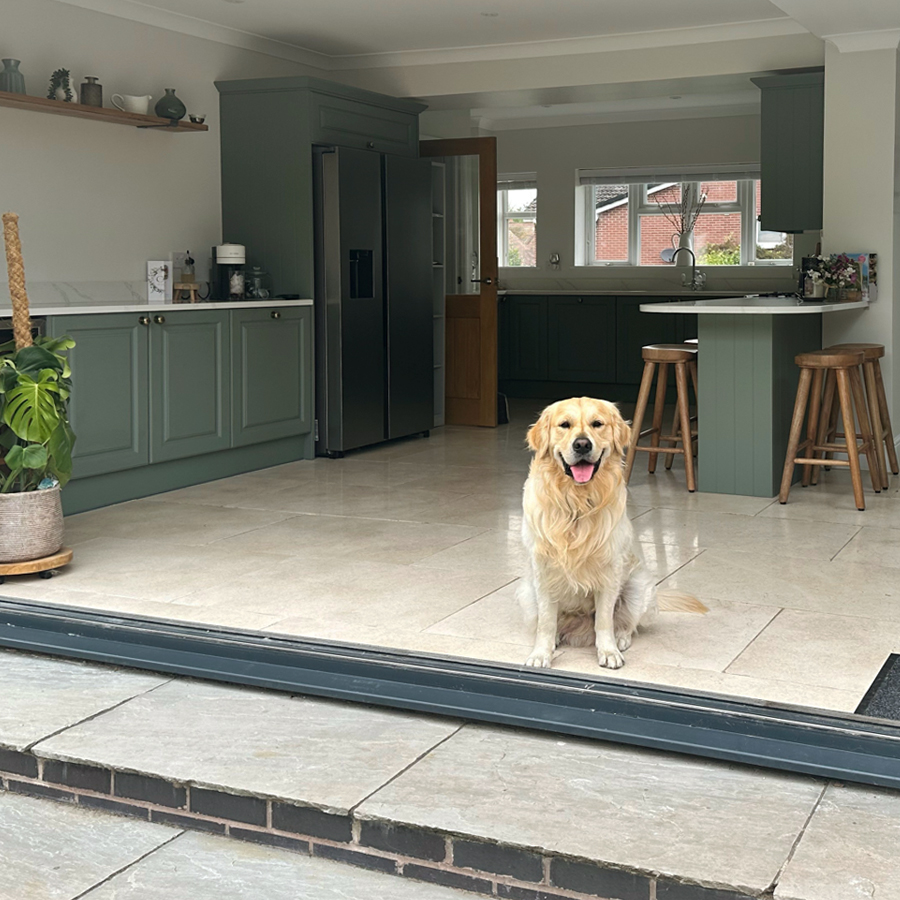
Avalon Limestone Natural Stone
Wooden flooring
Much like tile flooring, wood floors are a practical choice with an aesthetic appeal that is easy to clean in most regards.
Unfortunately, despite being well-suited for use in a space with constant movement, wood is not ideal for all pets. For example, no matter what sort of wood you choose, any active cat or dog is likely to scratch it one way or another.
Wood floors also come with the issue of easy staining and odour trapping. Even when varnished, urine has the habit of darkening your wood boards and leaving behind faint smells if you don’t catch it quickly. And while you could look to engineered wood to solve this issue, you likely find that this sort of design also suffers from the same issues.
However, with all that being said, if you want to avoid these wood-related problems while still retaining that classic wooden aesthetic, then you might want to consider investing in wood-effect porcelain tiles, which offer the same benefits as porcelain tiles while seamlessly mimicking a wood design.
Laminate flooring
Once one of the most popular pet flooring options out there, in recent years, laminate flooring has proven to be some of the worst flooring for dogs and cats. Not only is it prone to staining and deforming, but laminate can often become swollen when exposed to excess moisture, as it’s only water-resistant, not waterproof.
On top of this, laminate flooring is slippery and not very scratch-resistant, so pet marks are going to visibly show up after a while, especially after accidental skidding and scrabbling. And unlike wood, you can’t sand down laminate flooring in order to remove these blemishes.
LVT flooring
Similar to laminate flooring, LVT flooring is a suitable consideration for pet owners on a tight budget.
LVT flooring is extremely durable, easy to clean, and simple to install, being certainly one of the cheapest floor material options on the market. And with built-in underlay, click LVT flooring can be effective at insulating heat within a room, meaning your floors won’t get too cold for your pets to lie down on.
LVT flooring is a brilliant option to use throughout your complete home, as well as being water resistant. This makes it very easy to clean up after your pets, and you don’t need to worry about smells or staining becoming a long-term issue.
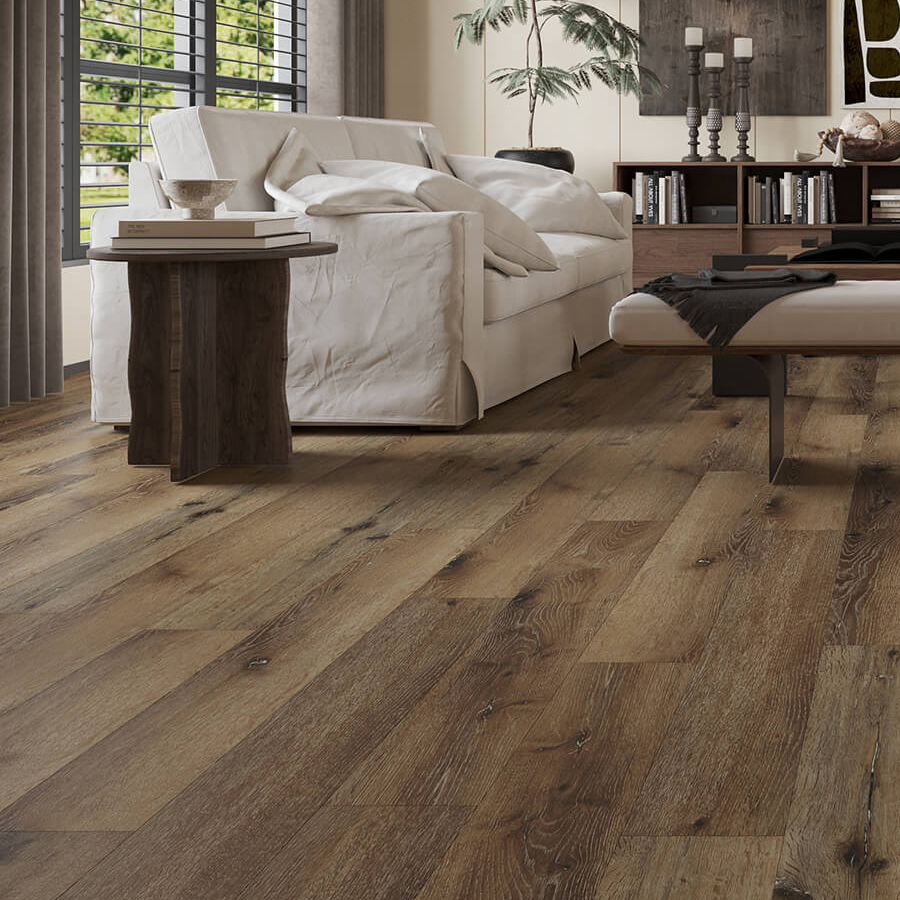
Aspen Walnut Click LVT Flooring
Carpets
Last, but not least, while they might be soft underfoot for our four-legged friends, carpets are not always ideal when living with pets. For one thing, it’s one of the worst flooring for dogs because of how absorbent this material can be, and it makes regular, permanent staining and persistent odours all but inevitable, and they’re not the best flooring for cats due to regular scratching.
On top of this, carpets are very good at trapping allergens, which is likely to make any pet allergies worse, even when they’re out of the room. However, if carpets are what you’re after, then it’s best to choose a dark or patterned shade, as these are at least much better at masking any stains you can’t fully remove.
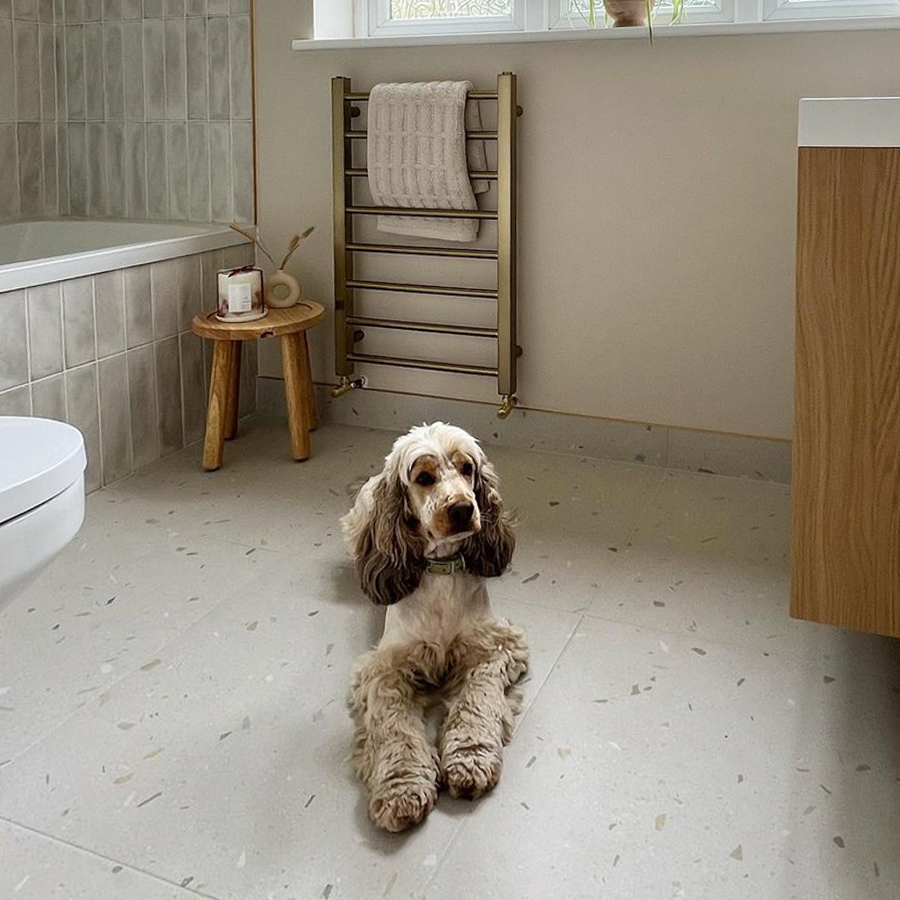
Tutti Frutti Cementi Porcelain Tiles
Which material makes the best flooring for pets?
Having looked at all the different flooring materials you’re likely to consider when buying pet-friendly flooring, that leaves only one question – which is the best flooring for pets? Well, here’s our opinion on what floor types to consider if you’re a cat or dog owner:
What’s the best flooring for dogs?
While we all want to make sure that our flooring is comfortable underfoot for our four-legged companions, at the end of the day, it’s hard to go wrong with a porcelain or stone tile floor for its durability, underfoot grip, and waterproof qualities.
Carpets and wood are simply not tough enough to handle the enthusiasm of new puppies, and even older pooches have a habit of wearing them down over time, while laminate’s tendency to warp and eventually absorb stains can make it a poor choice down the road.
However, stone and porcelain tiling can be an expensive investment, so for those homeowners on a budget, we’d recommend going with LVT flooring instead as a secondary alternative.
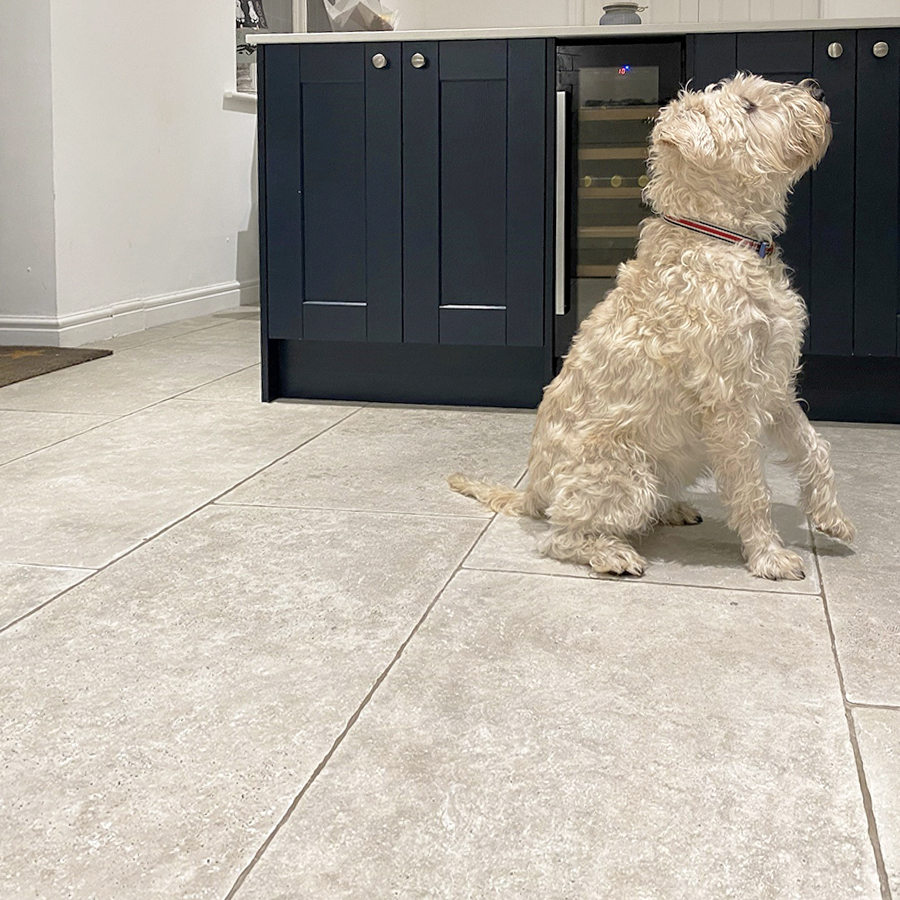
Antique Limestone-effect Porcelain Tiles
What’s the best flooring for cats?
Much like dog-friendly flooring, the best flooring for cats is again going to be porcelain and stone tiles, though LVT is also a close second in this regard as cats tend to cause less wear and tear when walking around.
However, we’d also argue that carpets can be a viable option for cat owners, provided you take precautions. Strategically placed scratching posts are a must, as is a cut pile carpet, which tends to be more resistant to scratching and plucking.
What is the best flooring for dogs that pee?
If you’re planning on adopting a puppy, you’re probably already bracing for the toilet-training phase of growing. So, with this in mind, we’d once again recommend going with LVT or porcelain tile flooring as a cheap option that is waterproof and easy to clean when accidents do occur.
What’s the best flooring for a living room with pets?
Although the majority of flooring options we’ve recommended so far have focused on minimising wear-and-tear on your floor, when it comes to living room flooring, we think you can give yourself a little more leeway – after all, you want a floor that is cosy while also matching the aesthetic of this room.
Provided you’re careful in when you let your pet into your living room, there’s absolutely nothing wrong with sticking to a classic wood floor or carpet, both of which will be comfortable underfoot for you and your pet, but you can also stick to lounge tile flooring if it’s in keeping with the rest of your home’s style.
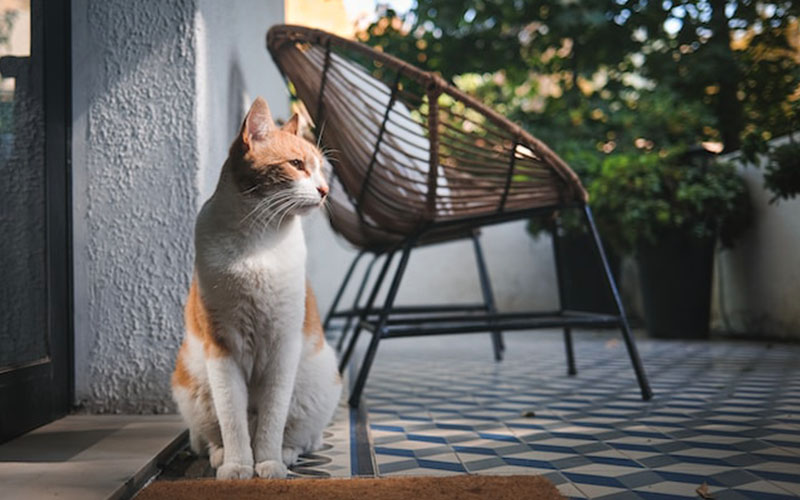
What is the best way to clean tile floors with pets?
Finally, if you already have tile flooring, then you might be wondering what the best way to clean tile floors with pets is.
Well, the good news is, if you keep on top of any necessary tile sealing, you can clean up pet mess as you would with any other tile dirt, though we would recommend using a pet-friendly cleaning product to protect your pets and ensure that all bacteria are removed.
Doing this also means you can target the dirty spot specifically, saving you from doing a full floor clean every time your dog or cat leaves muck behind. Just be sure the cleaner you choose is also a tile-friendly one, so you don’t damage your floors when scrubbing.
As for a more in-depth look into how to clean these sorts of indoor tiles, you can find the full breakdown in our blogs on how to clean natural stone tiles and cleaning porcelain tiles.
How can I stop my pets from making my floor dirty in the first place?
While it’s impossible for you to stop your pets from tracking in muck entirely, there are a few things you can do in your home to make cleaning up after them quick and easy:
- Always wipe up any mess they leave behind as soon as possible to prevent stains and odours – this is particularly important for any toilet-related accidents.
- Hoover regularly to stay on top of the battle against excessive pet hair.
- Mop your floor regularly to prevent any dirt from building up.
- Place mats under your pet’s bowls so that crumbs and water don’t hit the floor.
- Scoop out your litterbox every day so that smells don’t accumulate.
- Remember to reseal your floors every few years to keep them waterproof.
Find your ideal tile flooring in our range
With that out of the way, you should hopefully now have a much better idea of which sort of flooring is best for pets, and what you can do to make cleaning up after them that much easier. And if you’re interested in buying any of our tiles, then get in touch with the team at Stone Superstore today.
We’ve got an enormous range of tiles for you to choose from, including kitchen tiles and bathroom tiles, so why not order a free sample of your favourites today? And in the meantime, browse more helpful articles like this one in our inspiration hub for more advice around using tiles in your home.

